Understanding SpecFlow Framework and Running Tests on Cloud Selenium Grid
Kritika Murari
Posted On: July 5, 2021
![]() 17257 Views
17257 Views
![]() 6 Min Read
6 Min Read
Software depends on a team of experts who share their viewpoint to show the whole picture in the form of an end product. In software development, each member of the team makes a vital contribution to make sure that the product is created and released with extreme precision. The process of software design, and testing leads to complications due to the availability of different types of web products (e.g. website, web app, mobile apps, etc.).
The best way to eliminate this issue is to have a proper communication system between all stakeholders. Improved product quality can be achieved by involving a diverse set of members (e.g. product managers, software managers, non-technical members, and more) in the software testing process. This is where Behaviour Driven Frameworks (BDD) can play an instrumental role, as the test scenarios are written in simple and understandable English language. SpecFlow is one such BDD framework that is extensively used by the automation testing fraternity.
The advent of frameworks like SpecFlow has proven to be the most reliable solution for businesses, software organizations, and even standalone developers.
LambdaTest got together with SpecFlow to understand how the framework works to help eliminate such issues and how it can be used at scale using cloud Selenium Grid. In case you missed the Webinar, let us look at the major highlights of the event. If you are preparing for an interview you can learn more through SpecFlow interview questions.
About SpecFlow
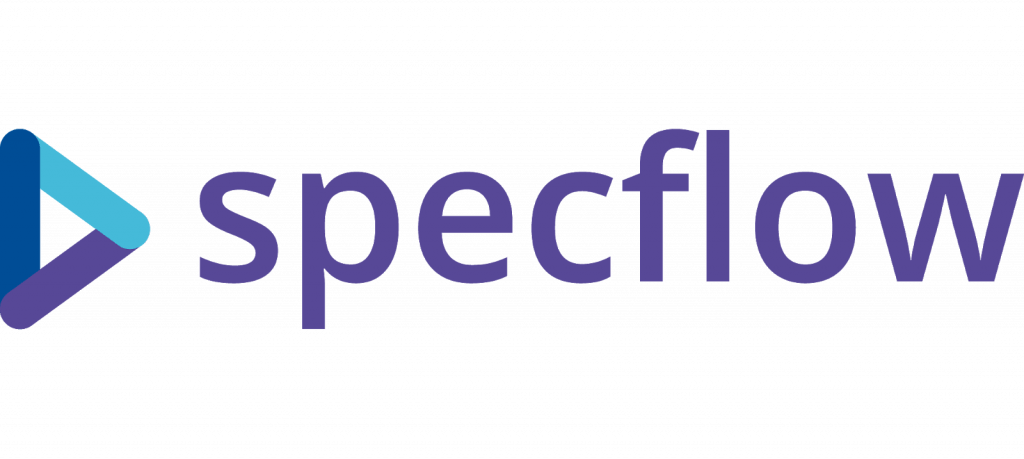
The story of SpecFlow started out in 2009, when the team decided to build a native .NET automation framework for automating Gherkin Feature Files. This was later released as SpecFlow on GitHub. SpecFlow is open-source, and free to use. It is actively developed, and maintained by the team and its active community members. For .NET platforms and Microsoft ecosystem, SpecFlow implements BDD.
SpecFlow truly believes that Specification-By-Example (SBE) and Behavior Driven Development (BDD) are inspiring ways of connecting software developers with business and change management stakeholders. Both are based on a shared understanding of what the software to be built is. The framework is created to help teams get aligned around the common understanding of specific business goals, functionality, and acceptance criteria. This is all about effective communication and collaboration which are indispensable to build great software.
Read – Behaviour Driven Development By Selenium Testing With Gherkin
These practices are based on extreme programming principles but extend them with formal semantics to drive product discovery and clarification of software system specifications. Here are some of the standout features of the SpecFlow framework:
- SpecFlow allows you to separate specifications and test automation, as well as provide tools for creating a maintainable coding structure.
- With SpecFlow, it is possible to focus on coding feature-logic instead of explaining it to stakeholders.
- For a customised BDD experience, you can integrate SpecFlow with tools such as LambdaTest, Appium, and Selenium.
- Every time you build a new version, you can run tests and generate complete documentation for your stakeholders.
- To create a shared understanding of software requirements, SpecFlow employs human-readable requirements descriptions.
- SpecFlow can help you find out exactly what the user needs, collaborate with the team and ship a top quality product.
In case you want to get started with the SpecFlow framework, do check out SpecFlow Tutorial For Automation Testing.
About the Webinar
In today’s software industry, achieving a quality bug-free release is entirely dependent on the quality of work done. Behavior Driven development (BDD) is an effective method of reducing the communication gap between stakeholders of the software projects, such as product owners, developers, and testers.
In association with SpecFlow,LambdaTest hosted a webinar on the importance of BDD in software development. In this webinar, Harshit Paul (Product & Growth Manager at LambdaTest) and Andreas Willich (Community Manager for SpecFlow) discussed how automation testing with Selenium can benefit from the integration of SpecFlow and LambdaTest Selenium Grid.
Andreas began the webinar by explaining Behavior-Driven development (BDD), its differences from Test-Driven development (TDD), and the importance of the SpecFlow framework in test automation.
Shown below is the agenda of the SpecFlow Webinar:
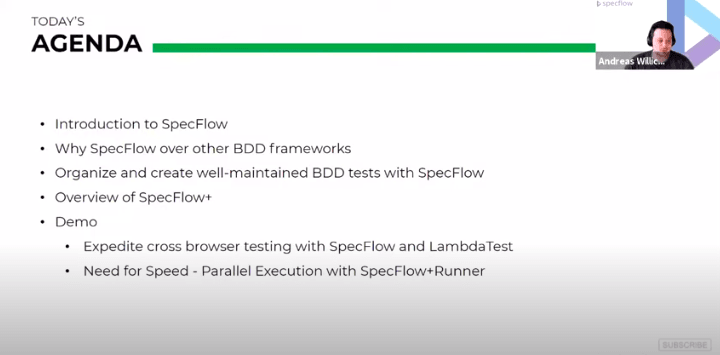
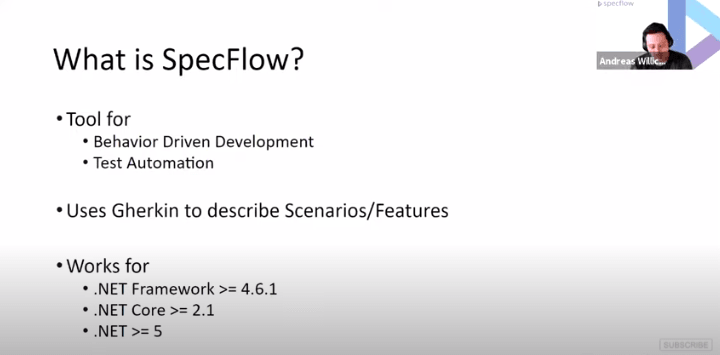
Take this certification to master the fundamentals of Selenium automation testing with C# and prove your credibility as a tester.
Here’s a short glimpse of the Selenium C# 101 certification from LambdaTest:
What is Behavior Driven Development
For those not familiar with Behavior Driven development, Andreas went ahead and explained everything there is to know about it. He also explained how BDD is actually an enhancement of TDD!
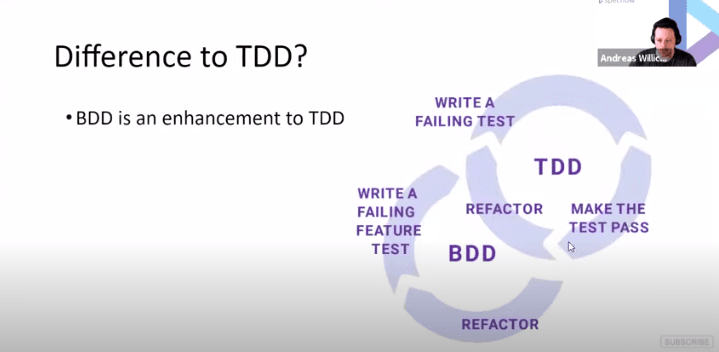
What is Gherkin
He introduced Gherkin and explained how it works. From Feature Description to Scenario, he gave a brief overview about Gherkin for the benefit of all the viewers. He used a concrete example of a Calculator to explain the usage of Gherkin feature files.
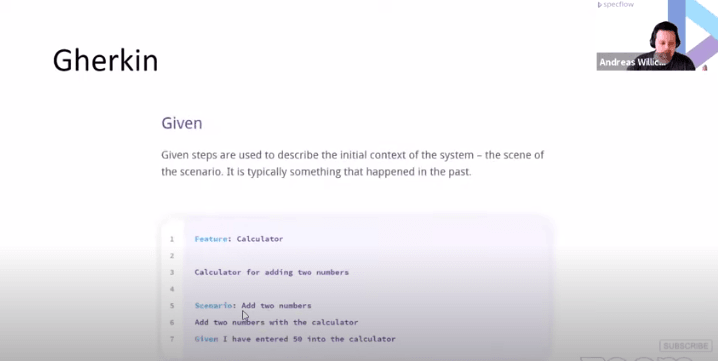
Here, the scenario is to add numbers, which can also have a description if required (this description will not affect the automation in any manner whatsoever). To get started, we have three important keywords in a scenario which can help you define the steps corresponding to the scenarios. Once you have done that, you can go ahead and automate these steps later on.
Then, he talked about the best practices to write the features files and demonstrated how SpecFlow seamlessly integrates with LambdaTest to execute multiple tests at a brisk pace.
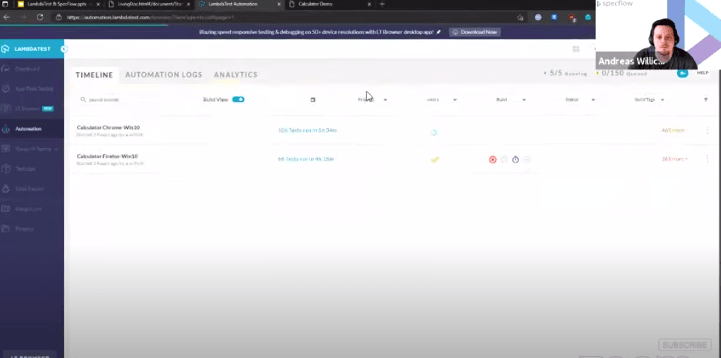
Here’s a step by step guide to run automation scripts on LambdaTest cloud grid using SpecFlow. Do check out our blog titled How To Perform Parallel Execution With Specflow, NUnit, And Selenium in case you want to run SpecFlow tests in parallel on the LambdaTest Cloud Grid.
Introduction to LambdaTest
In the second last segment, Harshit Paul introduced the LambdaTest platform and explained how it can be used to automate Selenium and Cypress testing. Additionally, he discussed in detail about the third-party integrations supported by LambdaTest, leveraging the data available in the automation dashboard, etc. In case you are using the Cypress framework, make sure to check out our blog that helps you Perform Cypress Testing at Scale.
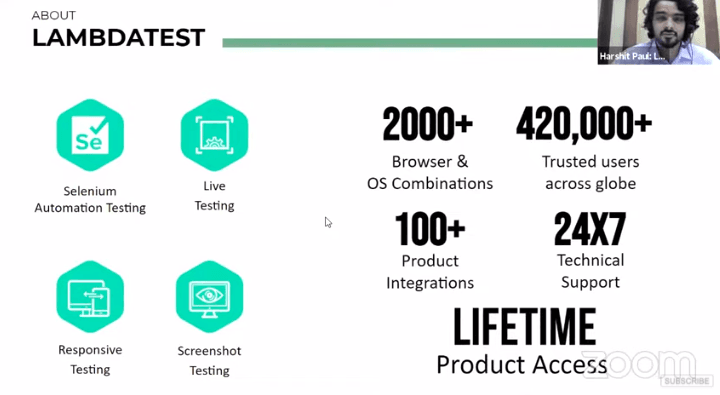
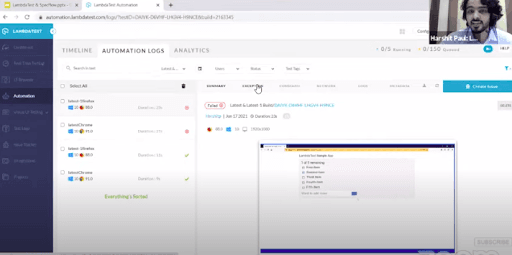
In the end, we had an engaging Q/A session. Intrigued to learn more about the SpecFlow framework and how it can be used effectively for cross browser testing? Do check out our exhaustive SpecFlow Selenium C# playlist on LambdaTest YouTube channel:
That’s all!
The webinar was a success, I hope you liked it. You can find the recording of the Webinar above, in case you missed it. Make sure to share this article with anyone who wants to learn more about behavior-driven testing with SpecFlow. Stay tuned for more exciting webinars. You can also sign up to receive our newsletter Coding Jag for the latest news on testing! With LambdaTest, you can enhance your SpecFlow testing by running SpecFlow tests on the cloud, allowing for greater scalability and collaboration among distributed teams.
That’s all for now, happy testing!
Got Questions? Drop them on LambdaTest Community. Visit now













